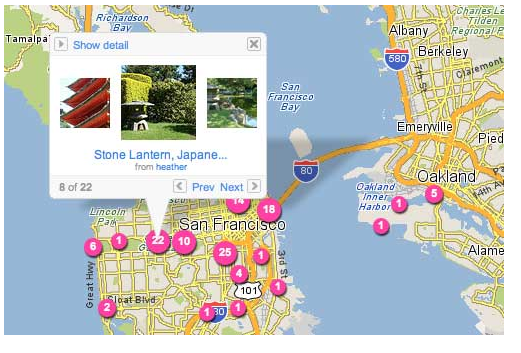Geotag, You’re It! Disabling GPS Coordinates
Geotagging allows others to track your location even though you don’t know it.
With the increased use of Internet-enabled mobile devices such as the Blackberry, Droid and iPhone, geotagging has seen a huge increase in popularity. When social media users take a picture or video and upload it to their page, they are probably transmitting far more data than they think. With the ability to quickly add GPS information to media, smartphones make geotagging a simple task.
So What is Geotagging?
Simply, geotagging is where location or geographical information, such as your GPS coordinates, are added and embedded to different types of media (.jpg, .mov files, etc.). Invisible to the naked eye and the casual observer, geotags are part of the meta-data, or underlying data about the data, that accompanies each file. Examples of meta-data include when the file was created or modified, by whom, using what device and software. This data is often loaded on to your computer along with the original file. Browser plug-ins and certain software programs can reveal the location information to anyone who wants to see it.
Twittervision makes great use of geotagging. Twittervision is a web mashup combining Twitter with Google Maps to create a real time display of tweets across a map (see photo above). It also has a 3D mode that displays a globe of the Earth which spins to pinpoint arriving messages from Twitter.
So, who would want to know where you are?
While most of the uses are not fully apparent yet, your real-time location can reveal your home address, work address, places you visit often and at what time of day. It can reveal if you go to the doctor, a lawyer, a court date, or any other type of private meeting. Geotags make it very easy for friends, relatives, bosses, spouses, parents, enemies, law enforcement, stalkers, and thieves to know exactly where you are.
Telling everyone on your Facebook status that you are out for the evening can invite burglars; geotagging can do the same without you updating your status in any way. By taking a picture at the Barry Manilow concert and uploading it to your twitter account, you are broadcasting the fact that you are probably over 40, away from home and, thanks to the geotag, exactly how far away you are.
If you’ve never seen Minority Report with Tom Cruise (where ads are served up to you on giant screens based on biometrics and your current location as you walk through the city ), it’s worth your time. Of course the movie exaggerates reality, that is one of the hallmarks of science fiction. But it does so in order to make you think about the possibilities and future realities. And that is exactly what corporations are doing. Using geotags that you upload into social networks (photos, videos, check-ins), they can see that you enjoy Starbucks and live in a certain neighborhood, so they may purchase a billboard in the area or more likely, target an ad to you on your Facebook wall. Although this can seem harmless, it will eventually raise larger concerns on consumer privacy.
In this fast paced electronic world, more and more people are using smartphones and therefore we can expect an increased use of geotags in the future. The problem with geotagging is that since it is not visible to the naked eye, most people don’t even realize they are sharing their location data. So what if you don’t want to transmit your location data?
Keeping location data private can be difficult, but here are some places to start:
- Understand that anytime you take a picture, video or post an update from a networked device (somehow connected to the internet), your location is probably being appended to the file, even though it is hidden from you. As with all things technological, there are advantages and disadvantages to all features. Location based services also allow you to use handy tools like maps; give you Big Brother-like power in tracking your kids’ whereabouts, and allow thieves to burgle you when no one is home using tools like Foursquare and Facebook Places.
- Disable geotagging application by application on your iPhone 4. In your phone, go to Settings, General, Location Services. Here you can set which applications can access your GPS coordinates, or disable the feature entirely (which could cause you problems using maps, restaurant finders, etc.)
- Disable geotagging for photos on your BlackBerry. Go into picture-taking mode (HomeScreen, click the Camera icon), press the Menu button and choose “Options”. Set the “Geotagging” setting to “Disabled”. Finally, save the updated settings.
- Disable geotagging for photos on your Droid. Start the Camera app (this is the menu on the left side of the camera application; it slides out from left to right). Select “Store Location” and make sure it is set to “Off”.
- Although Facebook does remove geotags from uploaded photos, other social networking sites do not. Look into your privacy settings and turn off location sharing. As mentioned above, you can generally turn this feature off in your camera or phone as well.
- Take particular care if you are uploading photos to a website where strangers will see them — such as Craigslist or Ebay.
- Consider installing a plug-in on your browser to reveal location data – such as Exif Viewer for Firefox or Opanda IExif for Internet Explorer, so you can see geotagged data for yourself.
- Take the time to stay informed about geotagging and other types of new technologies. By knowing what is out there, you can ensure the next photo or piece of media you upload won’t share your location with the World Wide Web.
John Sileo speaks professionally about social media exposure, identity theft and cyber crime for the Department of Defense, Fortune 1000 companies and any organization that wants to protect the profitability of their private information. Contact him directly on 800.258.8076 or visit his speaker’s website at www.ThinkLikeASpy.com.
Sorry, comments for this entry are closed at this time.










1 Trackbacks/Pingbacks
2 Responses to Geotag, You’re It! Disabling GPS Coordinates
Identity theft has become a major, major problem! And living without protection is like living in a crime infested neighborhood and not having protection on your home. You would probably at least have a really good guard dog and a fence right? Well, not protecting your identity today is the equivalent of living in that neighborhood and refusing to even lock your door. It’s so sad that it’s come to this, but there are always tradeoffs in life. Because we want better medical coverage and a nicer car we pay more to protect and insure them.
Likewise, with something as amazing as the World Wide Web there come tradeoffs also. One tradeoff for us having access to almost everything is that others have access to almost everything about us, our information. And that includes our personal information like social security numbers, banking information and even your medical and criminal history.
While some social networks allow users to hide this information, most do not. Additionally, free networks like Facebook, even recommend that users remove this data before sharing photos using their networks. read facebook’s privacy policy, sec. 2, last sentence. I would prefer to be in control of the information that I share with others so I use a free Photo Privacy Editor for iPhone, which lets me control when I share this type of information in my photos. It’s a simple tool and its free so why not be in control?